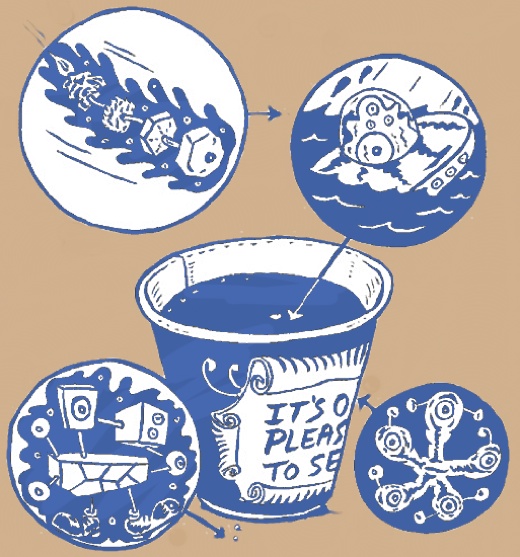 Image above: Illustration by David Sandlin for New York Times article.
Image above: Illustration by David Sandlin for New York Times article.
For centuries, speculation about the existence of life elsewhere in the universe was the preserve of philosophers and theologians. Then, 50 years ago last month, the question entered the scientific sphere when a young American astronomer named Frank Drake began sweeping the skies with a radio telescope in hopes of picking up a signal from an extraterrestrial civilization.
Initially, his quest was considered somewhat eccentric. But now the pendulum of scientific opinion has swung to the point where even a scientist of the stature of Stephen Hawking is speculating that aliens exist in other parts of our galaxy.
The search for extraterrestrial intelligence is predicated on the assumption, widely held today, that life would emerge readily on Earth-like planets. Given that there could be upward of a billion Earth-like planets in our galaxy alone, this assumption suggests that the universe should be teeming with life.
But the notion of life as a cosmic imperative is not backed up by hard evidence. In fact, the mechanism of life’s origin remains shrouded in mystery. So how can we test the idea that the transition from nonlife to life is simple enough to happen repeatedly? The most obvious and straightforward way is to search for a second form of life on Earth. No planet is more Earth-like than Earth itself, so if the path to life is easy, then life should have started up many times over right here.
Searching for alternative life on Earth might seem misconceived, because there is excellent evidence that every kind of life so far studied evolved from a common ancestor that lived billions of years ago. Yet most of the life that exists on Earth has never been properly classified. The vast majority of species are microbes, invisible to the naked eye, and scientists have analyzed only a tiny fraction of them. For all we know, there could be microbes with other ancestral origins living literally under our noses — or even inside our noses — constituting a sort of shadow biosphere, containing life, but not as we know it.
The denizens of the hidden “alien” biosphere — let’s call them Life 2.0 — might employ radically different biochemical processes than the life we know and love. Microbiologists could easily have overlooked their existence, because their methods are focused on the biochemistry of standard life. Obviously, if you go looking for A, you will find A and not B.
One way to go about tracking down Life 2.0 is to make educated guesses about what its biochemistry might be like. Alternative microbes might, for example, have different chemical elements. One shrewd suggestion, made by Felisa Wolfe-Simon of the United States Geological Survey, is that phosphorus — crucial to life as we know it — could be replaced by arsenic. She and her colleague Ron Oremland are dredging bugs from arsenic-contaminated Mono Lake in California in search of arsenic life.
Other researchers are focusing on the handedness of molecules. In standard life, the key amino acids are always left-handed, and the sugars are right-handed. Scientists are not sure why standard life has made this particular choice; nonliving chemical mixtures tend to contain equal amounts of both left- and right-handed molecules.
If life started again, perhaps it would select different handedness for its key molecules. Should a shadow biosphere of “mirror microbes” exist, the organisms could be identified by culturing microbial samples in “mirror soup” — a cocktail of nutrients with the handedness reversed, available from commercial suppliers. Standard life would find the soup unpalatable, but mirror life would thrive on it. Some experiments along these lines are being carried out at NASA’s Marshall Space Flight Center, in Huntsville. Ala.
Life 2.0 would be easier to identify if it inhabited distinct niches beyond the reach of regular life. Microbes are known to dwell in the superheated water around volcanic vents in the deep ocean, for example. Others survive extremes of cold, salinity, acidity or radiation. Yet all these so-called extremophiles that have been investigated to date are the same life as you and me. Regular life is clearly very hardy and adaptable, and can tolerate amazingly harsh conditions. Nevertheless, there will be limits. If Life 2.0 has a different chemical constitution, it may lurk in pockets at even more extreme temperatures or higher levels of radiation.
An argument often given for why Earth couldn’t host another form of life is that once the life we know became established, it would have eliminated any competition through natural selection. But if another form of life were confined to its own niche, there would be little direct competition with regular life. And, in any case, natural selection doesn’t always mean winner-takes-all. Some years ago it was discovered that simple microbes actually belong to two very distinct domains — bacteria and archaea. Genetically, these groups differ from each other as much as they differ from humans. Yet they have peacefully co-existed in overlapping habitats for billions of years.
If my theory turns out to be correct, it will have sweeping consequences. Should we find a second form of life right here on our doorstep, we could be confident that life is a truly cosmic phenomenon. If so, there may well be sentient beings somewhere in the galaxy wondering, as do we, if they are not alone in the universe.
No comments :
Post a Comment